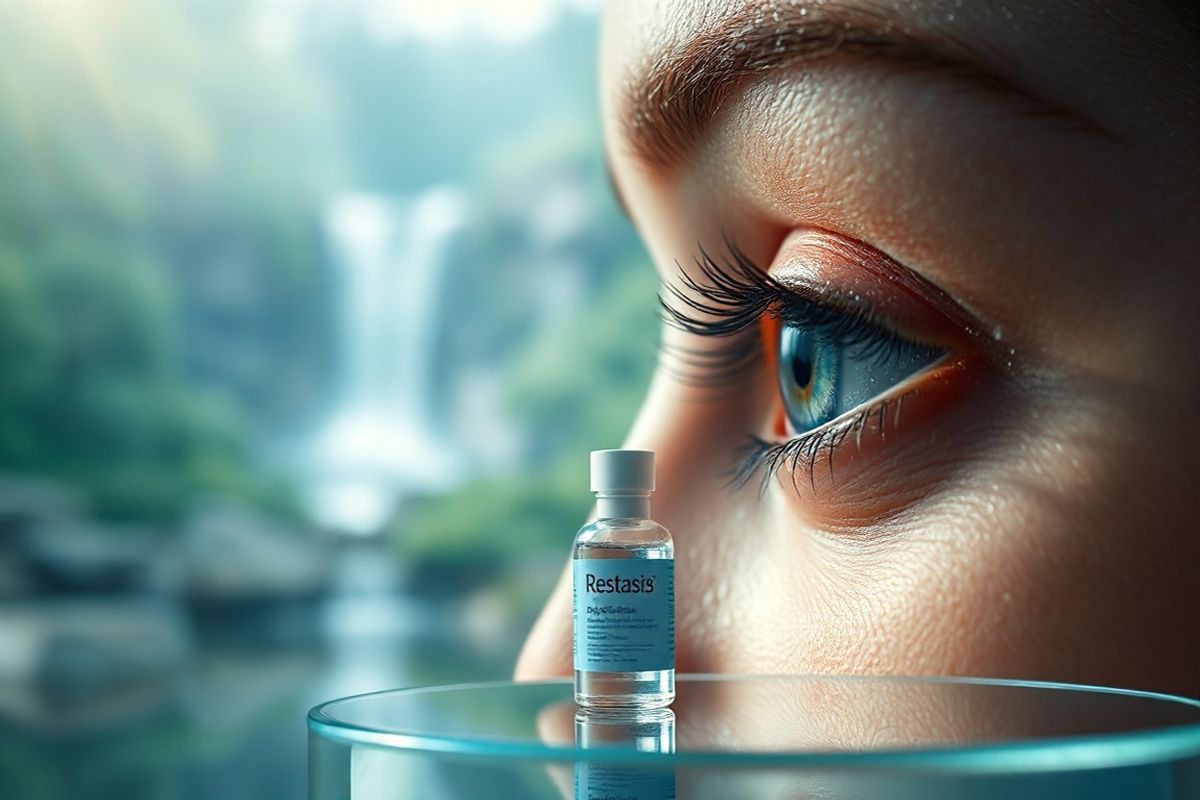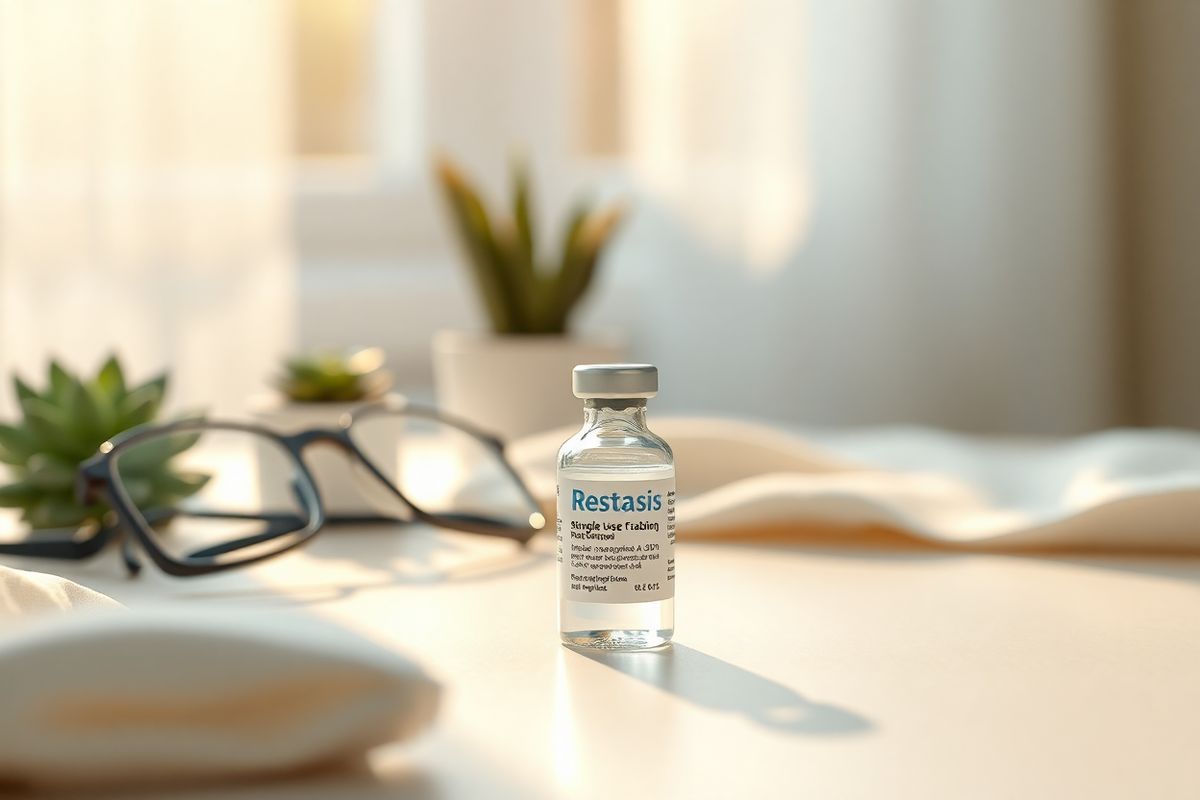Table of Contents
Understanding Restasis: What It Is and How It Works

Restasis is a topical ophthalmic formulation of cyclosporine A, an immunosuppressive agent that modulates the immune response. By inhibiting the activation of T-lymphocytes, Restasis reduces inflammation in the lacrimal glands, which can lead to improved tear production. This mechanism is particularly beneficial for patients suffering from chronic dry eye, especially those related to autoimmune conditions like Sjögren’s syndrome (Akpek, n.d.).
When applied, Restasis targets the underlying inflammation of the ocular surface, which is often the primary cause of reduced tear production. Clinical studies have shown that consistent use of Restasis leads to a significant increase in tear production, thereby alleviating symptoms of dryness, burning, and discomfort associated with DES (National Eye Institute, n.d.).
The Importance of Dosage: Restasis Forms and Strengths Explained

Restasis is available in single-use vials, typically containing 0.05% cyclosporine A solution. Each vial is designed for one-time use, ensuring sterility and preventing contamination. The recommended dosage is one drop in each eye twice daily, spaced approximately 12 hours apart. It is crucial for patients to adhere to the prescribed dosage to achieve optimal results.
| Dosage Form | Concentration | Recommended Use |
|---|---|---|
| Single-use vials | 0.05% cyclosporine A | 1 drop in each eye, twice daily |
Patients are advised to avoid touching the dropper tip to any surface, including the eye, to maintain the solution’s sterility.
How to Use Restasis: A Step-by-Step Application Guide
Proper application of Restasis is essential for maximizing its effectiveness. Here’s a step-by-step guide on how to use Restasis correctly:
- Wash Your Hands: Always start with clean hands to avoid introducing bacteria into your eyes.
- Prepare the Vial: Shake the vial gently to ensure the solution is mixed well. Open the vial and hold it upright.
- Tilt Your Head Back: Position yourself comfortably, tilting your head back slightly.
- Administer the Drop: With your other hand, gently pull down your lower eyelid to create a small pocket. Bring the vial close to your eye (but not touching) and squeeze it to release one drop into the pocket.
- Close Your Eyes: After administering the drop, close your eyes gently for a minute or two. Do not blink forcefully or rub your eyes.
- Repeat: If using in both eyes, repeat the process for the other eye.
- Dispose of the Vial: Once used, discard the vial immediately. Do not save leftover solution for later use to prevent contamination.
Potential Side Effects: What to Expect When Using Restasis

As with any medication, Restasis may have side effects. Common side effects include:
- Burning Sensation: A transient burning sensation immediately after instillation.
- Redness: Mild redness in the eye due to the formulation.
- Discharge: Increased eye discharge or crusting upon waking.
- Itchy Eyes: Temporary itchiness that typically resolves quickly.
In rare cases, serious side effects may occur, such as vision changes or severe eye pain. It is vital for patients to contact their healthcare provider if they experience any alarming symptoms (Cleveland Clinic, n.d.).
Managing Dry Eye Syndrome: Beyond Restasis—Additional Treatment Options
While Restasis is an effective treatment for many patients with dry eye syndrome, additional options may be necessary, especially for those who do not respond adequately to Restasis alone.
Other Treatment Options
- Artificial Tears: Over-the-counter lubricating eye drops can help relieve mild symptoms of dryness.
- Punctal Plugs: These small devices are inserted into the tear ducts to block drainage and help retain tears in the eye.
- Lifitegrast (Xiidra): Another prescription eye drop that reduces inflammation and increases tear production.
- Nutritional Supplements: Omega-3 fatty acids may help improve tear quality and reduce symptoms.
- Lifestyle Modifications: Recommendations include reducing screen time, using humidifiers, and wearing protective eyewear in windy conditions.
| Treatment Option | Description |
|---|---|
| Artificial Tears | Over-the-counter drops for lubrication |
| Punctal Plugs | Devices to block tear drainage |
| Lifitegrast (Xiidra) | Prescription drops to enhance tear production |
| Omega-3 Supplements | Nutritional aid to improve tear quality |
| Lifestyle Modifications | Changes to reduce symptoms |
FAQs
How long does it take to see results from Restasis?
Patients may begin to notice improvements in tear production and symptoms within 3 to 6 months of consistent use.
Can I use Restasis with other eye drops?
Yes, but it is recommended to wait at least 15 minutes between using Restasis and any other eye drops to ensure proper absorption.
Is Restasis safe for long-term use?
Yes, Restasis is generally considered safe for long-term use; however, patients should have regular follow-ups with their healthcare provider to monitor eye health.
Will Restasis cure my dry eye?
Restasis is designed to manage symptoms and improve tear production, but it may not completely eliminate dry eye syndrome, especially if caused by underlying conditions.
What should I do if I miss a dose of Restasis?
If you miss a dose, apply it as soon as you remember. If it is close to the time of your next dose, skip the missed dose and continue with your regular schedule. Do not double up to make up for a missed dose.
Conclusion
Restasis is a critical option for individuals suffering from dry eye syndrome, providing relief through its unique mechanism of action. Understanding its use, potential side effects, and complementary treatment options can empower patients to manage their condition effectively. With proper care and adherence to treatment guidelines, individuals can significantly improve their quality of life and ocular health.
References
-
Akpek, E. M. (n.d.). Dry Eye. Retrieved from https://www.hopkinsmedicine.org/health/conditions-and-diseases/dry-eye
-
National Eye Institute. (n.d.). Dry Eye: Symptoms, Common Causes & Treatment. Retrieved from https://my.clevelandclinic.org/health/diseases/24479-dry-eye
-
Clegg, J. R., Adebowale, K., Zhao, Z., & Mitragotri, S. (2024). Hydrogels in the clinic: An update. Bioengineering & Translational Medicine
-
Wu, K. Y., Yakobi, Y., Gueorguieva, D. D., Mazerolle, É., & Mihaylov, I. B. (2024). Emerging ocular side effects of immune checkpoint inhibitors: A comprehensive review. Biomedicines. https://doi.org/10.3390/biomedicines12112547










